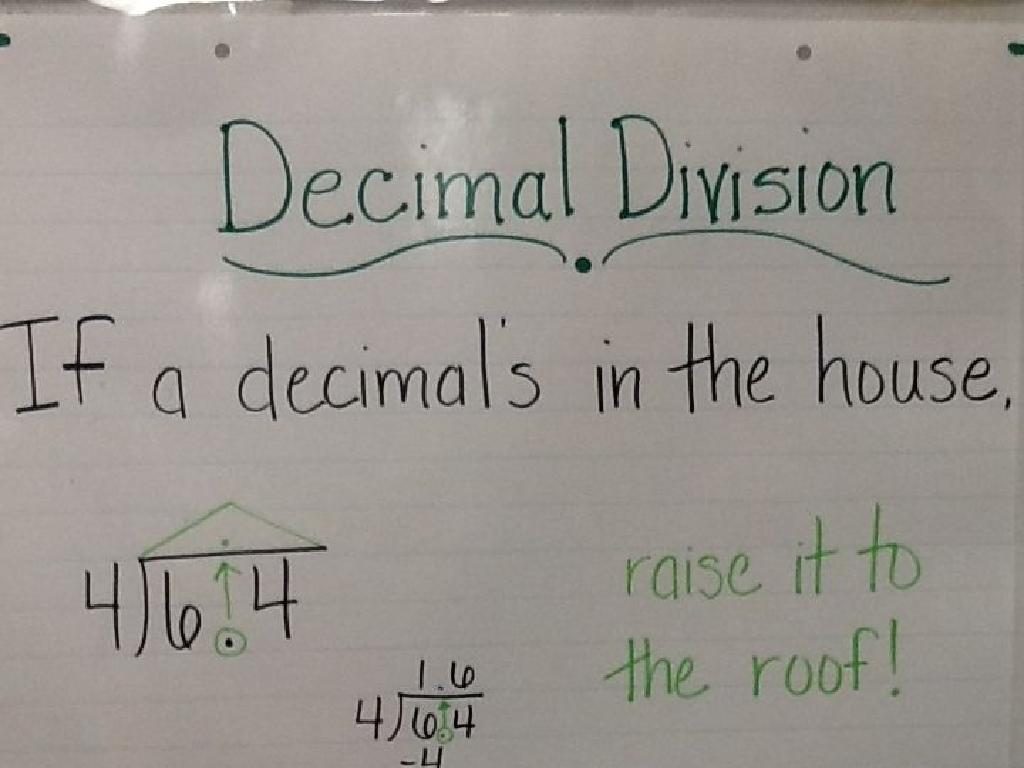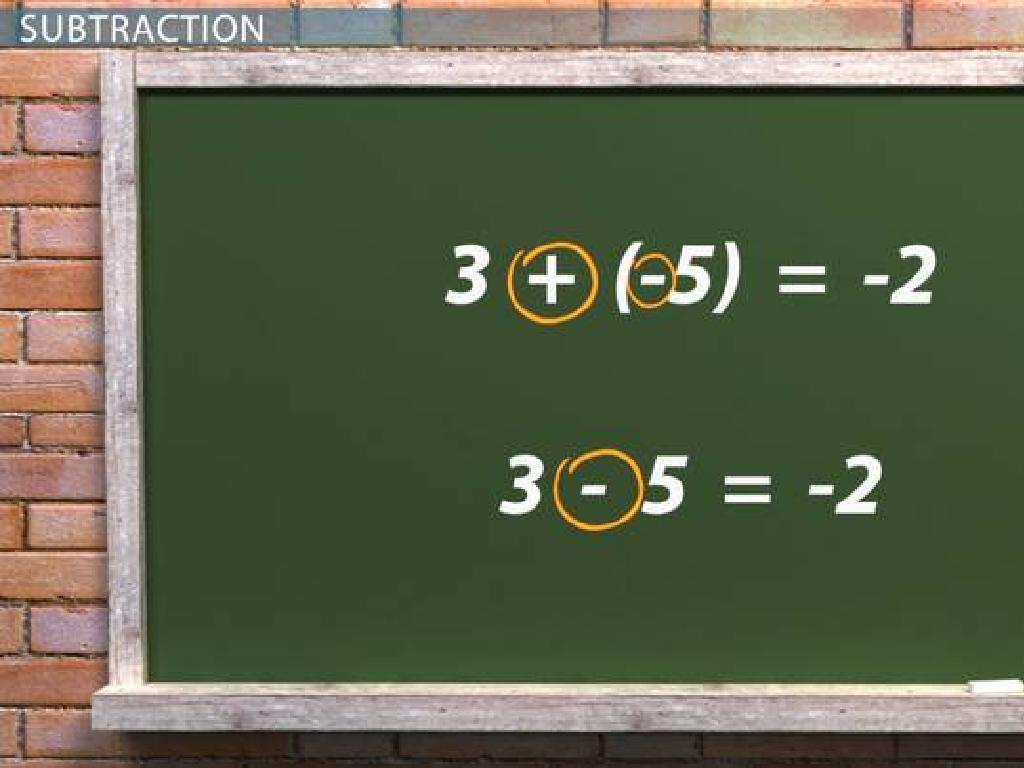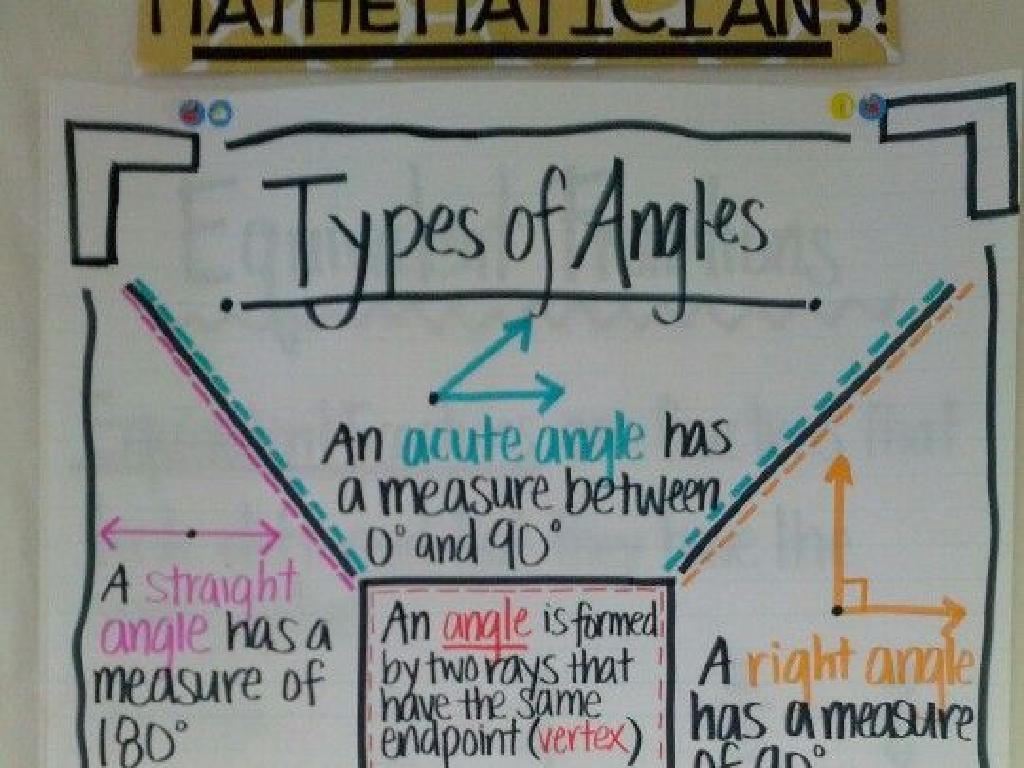Two-Step Mixed Operation Word Problems
Subject: Math
Grade: Third grade
Topic: Two-Step Word Problems
Please LOG IN to download the presentation. Access is available to registered users only.
View More Content
Mastering Two-Step Word Problems
– What are Two-Step Word Problems?
– Problems that require two operations to solve.
– Importance in Math & Real Life
– Helps with critical thinking and everyday situations.
– Today’s Goal: Solve Multi-Step Problems
– Learn methods to tackle problems step by step.
– Practice with Examples
– Use examples like combining allowances and buying toys.
|
This slide introduces students to the concept of two-step word problems, which are mathematical questions that require two separate operations to find the solution. Emphasize the importance of these problems in developing critical thinking skills and their practical application in real-life scenarios, such as budgeting or cooking. Today’s goal is to equip students with strategies to break down complex problems into manageable steps. Provide examples that are relatable to third graders, such as calculating total savings from a weekly allowance and then spending on toys or other items. Encourage students to think about the order of operations and to carefully read the problem to determine which steps to take first.
Understanding Two-Step Word Problems
– Definition of two-step problems
– A math problem needing two operations to find the solution.
– Types of operations involved
– Operations include addition, subtraction, multiplication, division.
– Practice identifying steps
– We’ll learn how to spot the two steps in a problem.
– Solving with examples
– Let’s solve a sample problem together.
|
This slide introduces students to the concept of two-step word problems, which are problems that require the use of two different mathematical operations to reach a solution. It’s important to explain that these operations can be any combination of addition, subtraction, multiplication, and division. Provide clear examples to illustrate how to identify and perform the necessary steps. Encourage students to think of each step as a separate problem to simplify the process. During class, practice with real-world examples and guide students through the process of breaking down the problems into manageable parts. This will help them build confidence in solving two-step word problems.
Key Words in Word Problems
– Identify operation keywords
– Words like ‘total’ and ‘sum’ signal addition
– Understand order of operations
– Knowing what to do first is crucial in two-step problems
– ‘Total’ and ‘sum’ mean add
– When you see ‘total’ or ‘sum’, you’ll add numbers together
– ‘Difference’ and ‘product’ mean subtract or multiply
– ‘Difference’ hints at subtraction, ‘product’ at multiplication
|
This slide is aimed at helping third-grade students recognize key vocabulary in word problems that indicate which mathematical operations to use. Understanding these words is essential for solving two-step mixed operation word problems. Teach students to look for words such as ‘total’ and ‘sum’ to identify when to add, and ‘difference’ for subtraction, ‘product’ for multiplication. Emphasize the importance of the order in which they perform these operations. Provide examples and practice problems where students can apply this knowledge, ensuring they understand the concept of performing two different operations in sequence to solve a problem.
Solving Two-Step Word Problems
– Read the problem as a group
– Find the two steps to solve
– What operations do we use? Add, then subtract?
– Work through the problem together
– Use numbers and operations to find the answer
– Review our solution method
– Did we solve each step correctly?
|
This slide is aimed at guiding the class through the process of solving two-step mixed operation word problems. Start by reading the problem aloud to ensure all students understand it. Next, discuss and identify the two steps required to find the solution, which may involve different operations such as addition followed by subtraction. Solve the problem collectively, with students contributing to each step. Finally, review the solution method to reinforce the concept and ensure comprehension. For the activity, consider having different word problems for groups to solve, encouraging collaboration and discussion among students. Provide guidance and support as they work through the problems.
Let’s Practice Together: Solving Two-Step Problems
– Work on a new word problem
– Discuss each solution step
– What operations to use and why?
– Verify our solution
– Does the answer fit the question?
– Reflect on our answer
– Understanding the reasoning behind our steps
|
This slide is designed for a collaborative class activity where students and teacher solve a two-step word problem together. Start by presenting a new problem to the class, encouraging them to think about the operations needed to solve it. Discuss each step of the solution process, ensuring students understand why each operation is used and in what order. After solving, check the answer together to see if it makes sense within the context of the problem. Finally, reflect on the answer and the steps taken to get there, reinforcing the concept of two-step problem-solving and the importance of logical reasoning in math. Prepare 4-5 similar problems with varying contexts and operations for students to practice independently after the group activity.
Your Turn: Solve the Problem
– Attempt the problem independently
– Identify the two steps involved
– First, find the total cost. Second, calculate the change.
– Partner up for collaborative solving
– Share ideas and compare strategies
– Group review of the solutions
– Discuss different methods and answers
|
This slide is an interactive activity designed to engage students in solving a two-step mixed operation word problem. Encourage students to first try to solve the problem on their own, ensuring they understand the need to perform two separate calculations to arrive at the answer. They should identify what the two steps are, such as adding to find a total and then subtracting to find the remaining amount. If they struggle, suggest partnering up to discuss the problem and share strategies. Conclude the activity with a group review where students can present their solutions and discuss the different methods used to solve the problem. This collaborative approach reinforces learning and problem-solving skills.
Tips for Success: Solving Two-Step Word Problems
– Carefully read the entire problem
– Understand what the question is asking
– Write down the known information
– Numbers, operations, and what’s being solved for
– Plan your solution steps
– Decide which operation to use first
– Solve the problem step by step
– Check each step to ensure accuracy
|
This slide is aimed at providing students with a structured approach to solving two-step mixed operation word problems. Emphasize the importance of reading the problem thoroughly to avoid missing key details. Encourage students to jot down all the information they gather from the problem, such as numbers and what is being asked. Planning is crucial; they should determine the order of operations before starting to solve. Finally, solving the problem step by step helps maintain organization and reduces errors. In the next class, we can practice this method with example problems and have students explain their thought process for each step.
Class Activity: Word Problem Scavenger Hunt
– Find two-step problems in class
– Solve problems in small groups
– Discuss solutions with classmates
– Share problem-solving strategies
– How did you approach the problem? What steps did you take?
|
This interactive class activity is designed to engage students in solving two-step mixed operation word problems by turning the classroom into a scavenger hunt. Place word problems around the classroom before the activity begins. Divide the class into small groups to encourage collaboration. Each group will search for and solve the problems they find, using their math skills to perform two operations in sequence. After solving, groups will reconvene to discuss their solutions and the strategies they used to find them. This will help students learn from each other and understand different approaches to problem-solving. Possible activities could include problems hidden in ‘treasure chests’ or behind ‘secret doors’ to make the activity more engaging. Ensure that the problems vary in difficulty and involve different operations (addition, subtraction, multiplication, division) to cater to the diverse skill levels within the class.
Conclusion: Mastering Two-Step Word Problems
– Summarize today’s learning
– Learned to solve problems with two steps using addition, subtraction, multiplication, or division.
– Understand importance of skills
– Solving these problems helps with critical thinking and real-life math applications.
– Homework: More practice
– Solve assigned word problems to become more confident in your skills.
– Reflect on problem-solving
|
Today, we’ve learned how to tackle two-step word problems that require a combination of mathematical operations. This skill is crucial as it lays the foundation for more complex problem-solving and helps students apply math to real-world situations. For homework, students should practice with additional word problems to reinforce their understanding and build confidence. Encourage them to approach each problem methodically, breaking it down into manageable steps. During the next class, we’ll review the homework and discuss any challenges faced, ensuring that students are comfortable with the concept and ready to progress.






